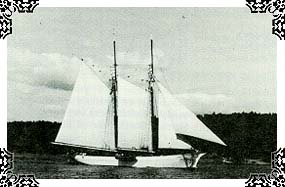








 In the mid-nineteenth
century, Prince Edward Island was experiencing a golden
age, with almost full employment and harbours busy with
commerce. While agriculture and the fishery certainly
contributed to the robust economy, the shipbuilding
industry was undoubtedly its driving force. Almost every
community that fronted on the water had its own
shipbuilding yard. Just in the vicinity of Kensington,
there were shipyards at Malpeque, Hamilton, New London,
and Margate (map). While Kensington itself is land-locked, it
experienced the trickle-down effects of the shipbuilding
boom. Area residents participated in every stage of a
vessel's construction-- from cutting the lumber to
forging the nails-- and the town's merchants shipped out
their goods in the newly constructed holds.
In the mid-nineteenth
century, Prince Edward Island was experiencing a golden
age, with almost full employment and harbours busy with
commerce. While agriculture and the fishery certainly
contributed to the robust economy, the shipbuilding
industry was undoubtedly its driving force. Almost every
community that fronted on the water had its own
shipbuilding yard. Just in the vicinity of Kensington,
there were shipyards at Malpeque, Hamilton, New London,
and Margate (map). While Kensington itself is land-locked, it
experienced the trickle-down effects of the shipbuilding
boom. Area residents participated in every stage of a
vessel's construction-- from cutting the lumber to
forging the nails-- and the town's merchants shipped out
their goods in the newly constructed holds.
The first ship built in Malpeque was a 74 ton schooner named the "Maria," launched in 1788. It was owned by Walter Patterson, who was also the Island's first governor. One of the earliest shipbuilders was Arthur Owen, who learned the trade from his father in Devonshire, England and continued to practice it after settling in Malpeque. Not only was Owen a shipbuilder, but also a seasoned mariner and captain of his own vessels. From 1778 to 1892, upwards of sixty ships were constructed at the Malpeque shipyard. And these ships were no mere rowboats. Built in French River in 1864, the "Louisa Montgomery" required a team of thirty horses to draw it the half-mile to its launching site.
Reuben Tuplin had a thriving shipbuilding operation in Hamilton, located roughly five miles outside Kensington. His establishment also boasted a cookhouse to feed his many workers and a blacksmith shop to forge all the necessary ironwork. Tuplin named three of his schooners after his three daughters. In a strange twist of fate, the vessel christened the "Lucinda Jane" was bordered by pirates and never heard from again, only weeks after Lucinda herself had died tragically by drowning.
But Tuplin was certainly not the only shipbuilder struck by misfortune. The steady parade of merchant ships in the North Atlantic was bound to attract its fair share of privateers, who tried to redirect ships to the Caribbean where they could pilfer the cargo. In 1812, the schooner ship "Mary" was built at Darnley Basin, and was soon loaded with cattle bound for Newfoundland. However, after setting sail from Malpeque, Captain Matthew Stewart and his four shipmates were taken hostage by American privateers. All might have been lost, except for the sudden appearance of a British vessel, which deterred the pirates just long enough to leave Stewart with the "Mary." But his troubles were far from over, as a squall suddenly rose and ran the ship aground on the shores of the Magdalen Islands. Even so, he fared far better than his four sailors, who were never heard from again. The "Mary" did not escape calamity for long, either. In December, 1816, it was wrecked outside the mouth of Antigonish Harbour, Nova Scotia, taking its crew and passengers down to a watery grave.
But Malpeque ships met with far more success than disaster. Shipbuilding brought a brisk and lucrative trade to the area, and spurred on the development of its fishery and farming, as the steady traffic of boats ensured that the fruits of land and sea could reach a wide range of markets. But by the 1870's, shipbuilding began to lose its luster. The quality and quantity of timber in the area decreased rapidly, as the shipyards cleared out all the best stands to keep up production. More significantly, the age of wooden ship was passing, as more and more steel steam ships were beginning to roll out across the waves. Finally, the building of the P.E.I. railway meant that trade was not now limited to ocean-going routes. Whereas shorefront communities like Margate and Malpeque had always controlled the region's trade, the passage of the rails through Kensington almost singlehandedly determined that commerce would shift inland.
With all these factors working against it, the Island's shipbuilding industry experienced a quick demise. In 1892, the "Katie Wall" became the last ship ever launched from Malpeque, marking the end of an era.